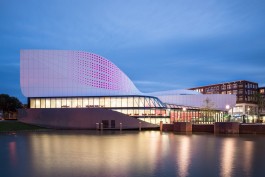



Theatre De Stoep, Spijkenisse (NL), Photo: Jan Paul Mioulet
An interview with architect and designer Ben van Berkel about the the dynamics and opportunities in modern product design and the self-conception of architects.
The work of UNStudio, which you founded, is theoretical as well as practical; it spans from complex city planning and architecture to interior design and product design. How far can product design in this context serve as a laboratory for experimental research, in terms of material, shape, even strategy?
Very far. The speed at which you can manufacture prototypes of products and the research into the characteristics and performance of specific materials provide a great testing ground. Within the world of product design many experiments take place with materials and how these are used. Certain production techniques also give us insight into how we could later apply these to architecture projects. So product design not only gives us a lot of ideas for materials, but also ideas about how these can be applied to geometrical constructs. But it also works the other way around. As architects we have so many references and examples of spaces and locations where we can imagine placing and using a particular product. If these opportunities did not exist for us, then it would be more difficult to adequately design the product for a given environment or for use within a particular context. We can constantly test our products in every environment that we work on, from the workspace to the future home and new forms of infrastructure – all these layers of knowledge can then influence the design of the product.



Singapore University of Technology & Design, Photo: Hufton+Crow
Due to today's technology, series production and individual customizing of objects or building parts are no contradiction anymore. How far have these developments changed architecture and design?
Today far more variety is possible through new production techniques and the interactive potentials of digital technology with machinery. From carpet design to furniture design and also in buildings, much more is now possible. In architecture modular systems enable great versatility: with a few repeated elements you can make many variations. The same is true of the customisation of products: this can now be done much more easily and inexpensively than was previously the case.
In fact, today's lifestyles do not differentiate that much any more between different “spheres” of our life – working, living, leisure intermingle. How can e.g. designs for office spaces profit from residential or hospitality projects, and vice versa?
There are indeed a lot of cross-overs. We learn a great deal from different typologies and as a result hybridise, or cross-combine information in our designs. For instance you can learn a great deal about wayfinding from infrastructural projects and then apply this to routing systems in individual buildings, like museums or office buildings. The same can be said for installation and construction techniques. Cross-combining knowledge like this is not something that we are taught to do as designers, but it should become part of the education of the architect - from engineering to all the invisible technology that can significantly influence our designs. So it is not just different typologies that influence each other, but also the technological, engineering side of architecture.

Villa NM, Photo: Christian Richters

W.I.N.D. House, Photo: Inga Powilleit

Mercedes Benz Museum, Stuttgart, Photo: Brigida Gonzalez
Do you think that the self-conception of the architect has changed, or has to change, also to regain relevance within a wider social discourse?
Definitely! This is in fact now demanded from the profession, both by politicians and the public. Social discourse is necessary in order to make architecture more responsible and relevant. For example, every commercial building within the planning strategy of a city will have public impact, so architecture is a public construct and architects today have to design with that understanding.


Soho Hailun Plaza, China, Photo: UNStudio

Profil
Ben van Berkel graduated as an architect at the Rietveld Academie in Amsterdam and the Architectural Association in London. In 1998, together with Caroline Bos, he founded the UNStudio (United Net) practice, a network of specialists in the fields of architecture, urban development and infrastructure. One of UNStudio’s projects known best internationally is the Mercedes-Benz Museum in Stuttgart.
www.unstudio.com

Ben van Berkel, Photo: Inga Powilleit